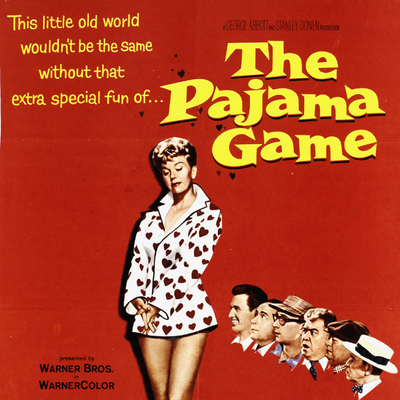There were dark clouds on the horizon when The Pajama Game was released in 1957. After a decade of incredible economic growth after the war, America went through the "Eisenhower Recession" – a sudden contraction in productivity and employment and a rise in inflation that would only last a year, though it might have made a movie version of Broadway musical about labour trouble in a pajama factory seem topical.
It was, however, a good time to be in the Doris Day business. After career-defining roles in Love Me or Leave Me (1955) and The Man Who Knew Too Much (1956), Day's stardom would survive small setbacks like Julie (1956) and The Tunnel of Love (1958) to become superstardom with Pillow Talk (1959).
During the Eisenhower Recession, Day would make Teacher's Pet (1958), one of her best straight comedies, and The Pajama Game, her last full-on movie musical, and her only shot at the kind of Broadway-to-Screen project that made the last decade of the classic Hollywood musical so vital. (The closest Day had come in her career was Calamity Jane (1953), Warner's response to the success of MGM's Annie Get Your Gun. And she would do only one more movie musical, Billy Rose's Jumbo, in 1962. Once she was a real star, Day rarely sang outside of the movie's title song playing over the opening credits.)
It was a creative flowering so undeniable (producing a decade of pictures like Oklahoma!, Guys and Dolls, South Pacific, The King and I, West Side Story, My Fair Lady, The Music Man and The Sound of Music) that no one seemed able to accept that its moment was ending when it finally came in the second half of the '60s. Moving a musical from the stage to the screen (Evita, Chicago, Hairspray, Rent, Jersey Boys, Matilda) is still the most reliable way to make a movie musical today.
In The Pajama Game, which opened on Broadway in 1954, Day plays "Babe" Williams, the head of the grievance committee and a union stalwart at Sleeptite Pajamas, where workers are preparing to lock horns with the factory owner, Mr. Hasler (Ralph Dunn), over a seven-and-a-half cent hourly raise. Into this battle steps Sid Sorokin (John Raitt), who convinces Hasler to hire him as superintendent and keep the workers in line.
Given the situation it would be a bad idea for Babe and Sid to fall in love, but that's exactly what happens, mostly because it's impossible to put people who look like Day and Raitt together under a proscenium or in a camera frame and imagine that isn't inevitable. In the meantime the picture does its best to people the shop floor with comic foils for the leads, starting with the alternate couple that was compulsory in this kind of story: Hinesy (Eddie Foy Jr.), the time study man in charge of the shop floor, and his girlfriend Gladys (Carol Haney), Hasler's secretary.
Rounding out the cast at Sleeptite is the matriarchal Mabel (Reta Shaw), Sid's secretary, Max the head salesman (Owen Martin), the beer-guzzling, man-chasing Mae (Thelma Pelish), Prez the philandering union president (Jack Straw) and Poopsie (Barbara Nichols), the ditzy blonde bombshell. Surrounding them, as on the Broadway stage, are "the kids" – the mostly nameless but attractive and energetic dancers who man the sewing machines and execute choreographer Bob Fosse's big numbers.
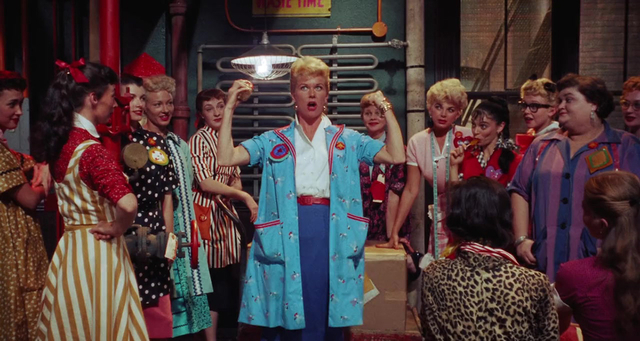
The original musical was based on a 1953 novel, 7 ½ cents, written by Richard Bissell, who based it on his time working for his family's Iowa garment business. When legendary Broadway producer/director George Abbott bought the book, Bissell co-authored the script with him, and went on to write another book, Say, Darling, about that experience.
The music was by two relative newcomers, Richard Adler and Jerry Ross, proteges of Frank Loesser who had their first hit with Tony Bennett's recording of "Rags to Riches" in 1953. It was also the first musical choreographed by Bob Fosse, who would work with Adler and Ross a year later on Damn Yankees.
This humble little production turned out to be star-studded: Jerome Robbins co-directed with Abbott, and Shirley MacLaine understudied for Carol Haney, taking over the role of Gladys when Haney injured her ankle, which led to MacLaine being scouted and signing as a contract player at Paramount. A London production opened in 1955, the same year that the show won Tony Awards for Haney and Fosse as well as best musical.
Most of the original Broadway cast were signed for the picture, including Raitt, Haney, Foy, Dunn and Shaw. Day – now a big star, returning to Warner Bros. as a free agent and commanding an appropriate salary – replaced Janis Paige as Babe. She had been billed below Paige on her first movie, Romance on the High Seas (1948) and would later compete with Paige for David Niven in Please Don't Eat the Daisies (1960) – one of the rare instances where a female co-star nearly stole a picture from Day.
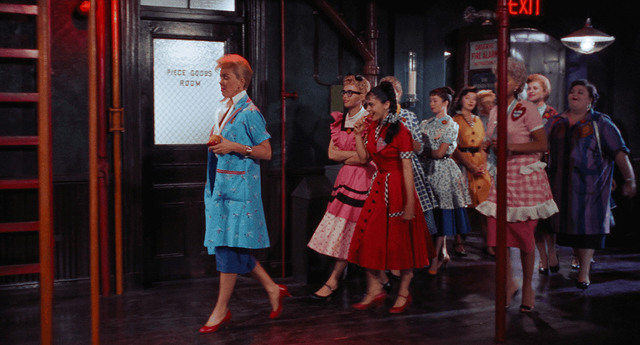
Writing about Day in The Movie Musical, Jeanine Basinger says that "after Love Me or Leave Me, she was always an actress who sang, and that ability to mold a dramatic force into her songs elevated her to the position she occupies today in retrospect: she's a legend. Her musicals are not throwaways. In The Pajama Game, she's Babe Williams, a hard-nosed working woman, and some of the grit and independence that had fueled Day's life was allowed to be seen onscreen."
The film, co-directed by Abbott and Stanley Donen, is a soundstage musical except for one key scene at the company picnic, where the whole cast perform the showstopper "Once a Year Day" – a showcase for Haney and the anonymous hoofers more than Day and Raitt – in scenes filmed in Los Angeles' Griffith Park. The home Babe shares with her widowed father, a railway engineer, is a stylized little place right next to the tracks, though the factory floor and offices at Sleeptite are so realistic they might as well have been shot on location.
Importing the whole cast of the Broadway show to the screen might have worked, though perhaps only if Donen (who truly understood what a movie musical needed if any man did) had replaced Robbins. But it would probably have been a minor hit, at best, and become a "cult classic" to be appreciated by movie musical aficionados – like How to Succeed in Business Without Really Trying (1967) or The Umbrellas of Cherbourg (1964).
But replacing Paige with Day turned the picture into more than an adaptation. As Basinger writes, "removing Paige and inserting a strong and well-established movie star automatically changed a show with a personality of its own into a star vehicle. The moviegoing public couldn't – and didn't – want it any other way. They were trained for the Doris Day musical, and her zippy performance and superb rendition of the hit songs overrode anything and anyone else."
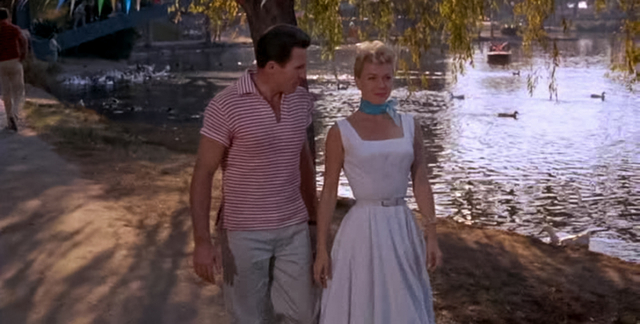
If there was any major drawback to casting Day as Babe, it was how poorly John Raitt fares with her onscreen. Writing about the film in Considering Doris Day: A Biography, Tom Santopietro writes that "Raitt is handsome and masculine, and has a great voice, but he is very stiff on camera, hunching his shoulders and acting vaguely ill at ease, as if he's always looking for the camera in order to make sure he'll hit his marks."
Indeed, most of the original Broadway cast members look like they're trying far harder than Day, mugging and gesturing broadly. Santopietro is unimpressed with Haney in particular, writing that she "spends too much screen time screaming at her jealous boyfriend Hinesy about his knife throwing, indeed screeching at seemingly anyone in her path."
There's no denying that Haney had a curious onscreen persona, though nobody doubted her credentials or talent as a dancer. She has assisted Gene Kelly on most of his MGM musical masterpieces like On the Town (1949), An American in Paris (1951) and Singin' in the Rain (1952), though studio executives had resisted his attempts to put her onscreen, saying that she wasn't attractive.
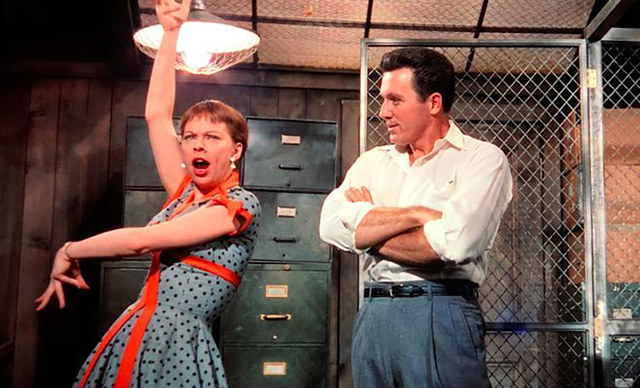
But she lit up the screen when she partnered Fosse for "From This Moment On", his big number in Kiss Me, Kate (1953), and when he cast her in a small dancing part for the Broadway production of The Pajama Game, she impressed Abbott so much that he created the role of Gladys just for her, and Fosse built two showstopper numbers around Haney: "Hernando's Hideaway" and "Steam Heat."
They're standout numbers in the picture, and like "Once a Year Day" they barely feature Day or Raitt. "Steam Heat" is one of Fosse's greatest hits, appearing inevitably in any compilation of his signature numbers, but like "Who's Got the Pain?" in Damn Yankees, it does nothing for the story. As Santopietro writes, "in structural terms, tuneful as both 'Steam Heat' and 'Hernando's Hideaway' are, they serve no actual story purpose. 'Steam Heat,' especially, features terrific, quintessential Bob Fosse choreography – all hunched shoulders and knocked knees – but neither number advances the plot or arises organically from the script."
(When the show was revived in New York in 2006, the producers gave the number to the actress playing Mae, reasoning (not incorrectly) that Gladys wouldn't try to make Hinesy even more jealous by dancing with two other men at a union meeting, and in any case why would the company owner's secretary be at a union meeting at all?)
But these weren't the sorts of inconsistencies that troubled Fosse, who loved to build numbers around the particular talents of his dancers; he'd do it again with "Rich Man's Frug" in Sweet Charity – another showstopper that features in any Fosse highlight reel – though by the time he made Cabaret he had learned to balance his need to show off with the requirements of his stories.
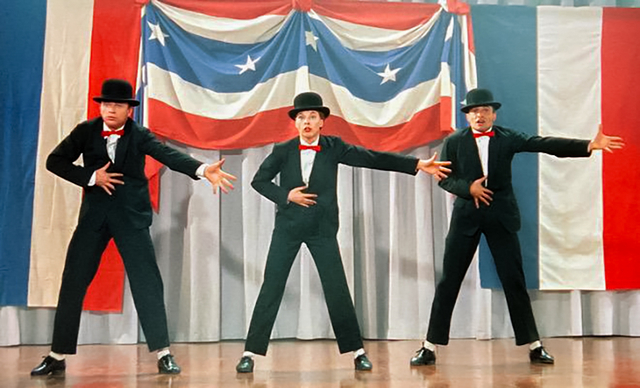
Assigned to come up with an amateur theatrical number for the union meeting, Fosse went to Adler and Ross, who said that they might have something, "but to be honest, it's just awful." They had written it as an exercise in response to a Frank Loesser song which Danny Kaye had turned into a novelty smash, "a big hit that went, 'Bloop, bleep, the faucet's dripping, and I just can't sleep,' so we tried to write one about noisy radiators and steam pipes."
It took five days for Fosse to create "Steam Heat" with Haney, Buzz Miller and Peter Gennaro (replaced by Kenneth LeRoy for the movie). It brought the house down on the opening night of the New Haven tryout, and George Abbott wasn't pleased, complaining that it stopped the show dead, though Robbins would insist that it remain. "The number is just too good," he said. "You can't throw it out."
But when Day was onscreen she more than justified the money Warners paid to cast her. Her Babe looks so good that it's easy to see why Raitt's Sid is willing to make his job a whole lot harder just to be with her, but it's her reprise of the number "Hey There" that seals the deal.
When Raitt sings it early in the picture it's the sound of a man unused to romantic rejection, cursing himself for allowing himself to be disappointed. ("Love never made a fool of you / You used to be too wise.") But when Day sings it alone in her room next to the railroad tracks after sending Sid away, insisting that he can't understand how important her work with union work is, it's imbued with the emotional resonance that was Day's secret superpower.
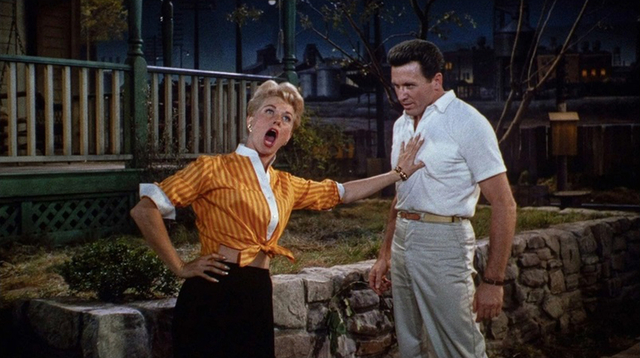
"Knowing that she had to cry during the song," Santopietro writes, "and feeling that this song constituted more of a dramatic scene than a song, Doris insisted on recording the vocal live, an unusual occurrence in a Hollywood musical. The gamble paid off. As with Barbra Streisand and her live recording of the 'My Man' finale to Funny Girl, the ensuing scene and the reprise of 'Hey There' gain in richness as a result. Day sounds terrific, and her vocal is every bit as good as the hit Rosemary Clooney recording of the same song."
But it's still hard to overlook how essentially strange The Pajama Game is, even in the context of Broadway's wildly imaginative golden era of the '50s and '60s. As Santopietro says "it's surely the only musical comedy in history to be centered on a union strike at a pajama factory" and "epitomized the brassy self-confident tone of Broadway and the United States in the '50s."
And this strangeness is distilled into one number, "7 ½ Cents", sung by Babe, Prez and the striking Sleeptite workers at their big rally. It's a declaration of union solidarity with an anthemic chorus where Babe and Prez work out what 7 ½ cents an hour, with overtime, works out to over five, ten and twenty years.
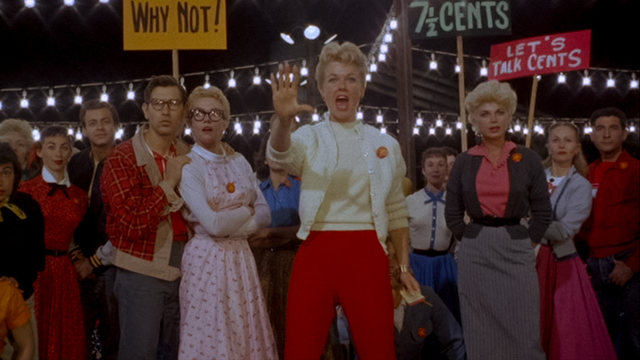
It doesn't seem like much, but after five years it means $852.74:
That's enough for me to get
An automatic washing machine,
A years supply of gasoline,
Carpeting for the living room,
A vacuum instead of a blasted broom,
Not to mention a forty-inch television set!
One wonders if there was even such a thing as a 40" TV set in 1957. Ten years with this precious rise in wages is $1705.48:
That's enough for me to buy
A trip to France across the seas,
A motorboat and water skis,
Maybe even a foreign car,
A charge account at the corner bar,
Not to mention a ping pong set with paddles made of gold!
This vision of golden ping pong paddles sounds like fantasy, but there's more. Twenty years of seven-and-a-half-cents added to every hour of work adds up to $3411.96:
Wow!
That's enough for me to be
A sultan in a taj mahal
In every room a different doll!
I'll have myself a buying spree,
I'll buy a pajama factory,
Then I could end up having old man Hasler work for me!
But hindsight tells us that this dream of worker ownership could never come true. Even if small annual increases in inflation didn't happen over the next decade, by 1977 the heretofore unimaginable economic phenomenon that was stagflation would have demolished the buying power of Sleeptite's wages, if the company had managed to survive until then.
Cheap foreign goods would have shuttered the factory by the '80s, if Sleeptite was still around to start outsourcing labour overseas. "Production must increase, costs must go down!" Hasler bellows at his employees even when he gives in on the raise (but not retroactive pay). But this is a churlish game to play, and it's better to marvel at the confidence and optimism that radiates from The Pajama Game's finale, even if we know something Sid, Babe and Prez don't.
Mark Steyn Club members can let Rick know what they think by logging in and sharing in the comments below, as access to the comments section is one of many benefits that comes along with membership in the Mark Steyn Club.

